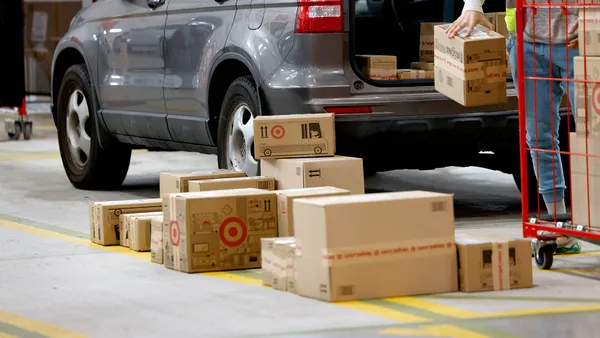Dive Brief:
- Wayfair's internal logistics operations faced a roughly 20% uptick in retail revenue as quarantined shoppers outfitted their homes in the first quarter, according to earnings released Tuesday. "We believe there are clearly definable long-term advantages accruing to Wayfair in this period," said CEO Niraj Shah of the opportunity shifts in shopping habits the pandemic presents for Wayfair.com, along with the company's other brands AllModern, Birch Lane, Joss & Main and Perigold.
- The company is in the process of hiring 1,000 workers to handle the volume, COO Thomas Netzer said on a Tuesday call with analysts. Wayfair has instituted temperature checks and masks and increased sanitizing at all fulfillment centers. It has also staggered shifts so they do not overlap, making contact tracing easier in the event a case of COVID-19 is identified.
- The retailer's quarterly net losses were up 43% year over year, but down compared to the previous quarter, which is uncharacteristic for the company in Q1. Executives see Wayfair as on the road to profitability after years of expensive capacity building. "Greater efficiencies are accruing from our logistics operations as we drive higher throughput, improve delivery speeds and incidence rates and lower costs in the process," said Shah.

Dive Insight:
Wayfair executives said in February that 2020 would be the year their investments in a global logistics network would pay off. Pandemic-driven revenue growth in the first quarter offered the company an opportunity to demonstrate just that through delivery execution and improved profitability — or at least less loss than the quarter prior.
The retailer spent the last five years building a massive logistics network that handles inbound and outbound transportation for roughly 30% of small parcel and 20% of large shipments resulting from platform sales. The rest is shipped directly from vendor to customer. Shah credited the dual model, along with added shifts at Wayfair fulfillment centers, with efficient handling of the extra volume.
"We're actually incredibly well-positioned to handle this type of unanticipated surge," said Shah. It helps that, as he has said in the past, Wayfair's warehouse and sortation capacity is generally ahead of demand.
"Today the utilization of the network is not anywhere near the full capacity, " Shah said in August. In February, executives said the building phase for the company's warehouse network was coming to an end and it was now time to generate volume to match it.
According to Netzer, now that the backend of the business is largely complete, profitability will come from as many "perfect orders" as possible — defined as orders that seamlessly reach the customer on time and with no damage, without any need for extra customer communication.
To increase perfect orders and make them even more cost-efficient the company is zero-ing in on labor utilization and increasing the level of automation at its fulfillment centers, in order to speed up ROI on its 15 million square feet of warehouse space across 65 global facilities, said Netzer.
Improving product availability through more accurate forecasting and therefore more optimized inventory positioning is a goal as well.
"We are developing new technology platforms to reinforce our already strong connectivity with our supplier partners. And to elevate the quality of our data exchanges, such as real-time inventory feeds and predictive lead times," said Netzer.
Though he said the pandemic has bolstered Wayfair's balance sheet, Shah insisted some of the benefit would stick around after stay-at-home orders expire.
"The gross margin trajectory, which we've talked about you're just seeing it start to manifest in the P&L ... This is not really COVID related," said Shah. "We are seeing is a huge secular shift from off-line to online. And there's no question. Part of it is temporary, but we do think part of it is permanent."















